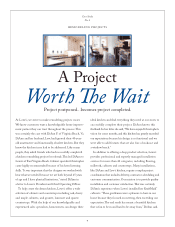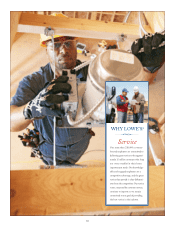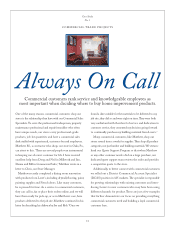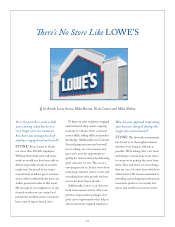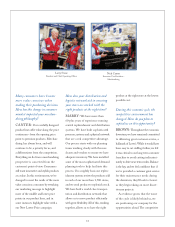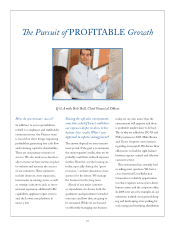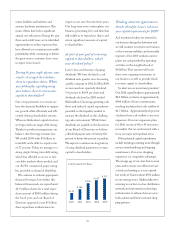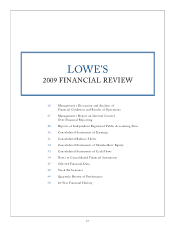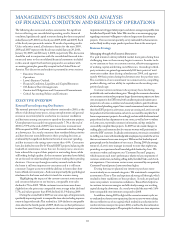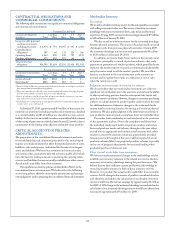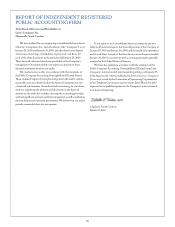Lowe's 2009 Annual Report Download - page 20
Download and view the complete annual report
Please find page 20 of the 2009 Lowe's annual report below. You can navigate through the pages in the report by either clicking on the pages listed below, or by using the keyword search tool below to find specific information within the annual report.
18
e following discussion and analysis summarizes the significant
factors affecting our consolidated operating results, financial
condition, liquidity and capital resources during the three-year period
ended January 29, 2010 (our fiscal years 2009, 2008 and 2007). Each
of the fiscal years presented contains 52 weeks of operating results.
Unless otherwise noted, all references herein for the years 2009,
2008 and 2007 represent the fiscal years ended January 29, 2010,
January 30, 2009, and February 1, 2008, respectively. is discussion
should be read in conjunction with the consolidated financial state-
ments and notes to the consolidated financial statements included
in this annual report that have been prepared in accordance with
accounting principles generally accepted in the United States of
America. is discussion and analysis is presented in seven sections:
• Executive Overview
• Operations
• Lowe’s Business Outlook
• Financial Condition, Liquidity and Capital Resources
• Off-Balance Sheet Arrangements
• Contractual Obligations and Commercial Commitments
• Critical Accounting Policies and Estimates
EXECUTIVE OVERVIEW
External Factors Impacting Our Business
e external pressures facing our industry continued in 2009, as the
effects of declining home prices, rising unemployment and general
economic uncertainty led to a reduction in consumer confidence
and hesitancy among consumers to spend on discretionary projects.
Unemployment increased from approximately 7.7% at the end of
2008 to 9.7% at the end of 2009, foreclosure rates increased over
20% compared to 2008, and home prices continued to decline, though
at a slower pace. As a result, consumers have reordered their priorities
and have become more deliberate in their spending decisions, as
evidenced by the significant decline in the rate of consumer spending,
and the increase in the savings rate to more than 4.0%. Consumers
have also shifted to more Do-It-Yourself (DIY) projects; balancing the
tradeoffs of convenience versus the cost. In many cases, consumers
have reduced the scope of their projects or are trading down, while
still looking for high quality. As the consumers’ priorities have shifted,
we are focused on understanding how they are making their spending
decisions. Our surveys through secondary research indicate that
the home is still very important to consumers and it is still most
consumers’ largest asset, even with the declines in home values they
have suffered over recent years. And more importantly, the psychological
attachment to the home and what it stands for remains strong.
Highlighting the impact of the current economic environment
and consumer behavior on our business, comparable store sales
declined 6.7% in 2009. While customer transactions were down
slightly from the prior year, comparable store average ticket declined
5.7%, and tickets greater than $500 declined 11.3% during 2009.
During the second half of 2009, we saw some signs of improvement,
specifically improving trends in comparable store sales, including improve-
ments in larger ticket sales. is resulted in a 1.6% decline in comparable
store sales for the fourth quarter of 2009, which was our best performance
in over three years. During the quarter, we also saw significant sequential
improvement in bigger ticket projects and above-average comparable store
Installed and Special Order Sales. We view this as an encouraging sign
regarding consumers’ willingness to take on larger, more discretionary
projects. Our most recent quarterly survey indicated that homeowners
are less likely to delay major product purchases than in the recent past.
Business Strategy
Managing through the Economic Downturn
Our goal remains to drive profitable market share gains during these
challenging times as the economy begins to recover. In order to do
so, we continue to focus on customer service, effective management
of working capital, and driving cost efficiencies. According to third-
party estimates, we gained approximately 100 basis points of total
store unit market share during calendar year 2009, and approxi-
mately 400 basis points during the downturn over the past four years.
is is evidence of our commitment to customer service, compelling
product offering, and our ability to capitalize on the evolving com-
petitive landscape.
Customer service continues to be a primary focus for driving
profitable sales and market share gains. rough the economic downturn
as consumers continued to postpone larger discretionary projects, we have
seen resurgence in the DIY trend with smaller repair and maintenance
projects in such areas as outdoor and seasonal products, paint, hardware,
electrical and plumbing repair. Since some homeowners have taken on
their first DIY project in a few years, many are coming to Lowe’s not only
for products, but for information on how to successfully complete their
home-improvement projects. Accordingly, we have added informational
project boards in key departments in our stores, as well as how-to videos
on Lowes.com, to provide customers information and tips needed to
successfully complete these projects. In 2009, we also made changes to
staffing plans and inventory levels to ensure we were well positioned to
serve the DIY customer. In all sales environments, we remain committed
to staffing our stores with knowledgeable employees to provide the service
that our customers have come to expect. We know that leadership and
great people are the foundation of our success. During 2009, the average
tenure of a Lowe’s store manager increased to more than eight years,
providing an experienced and knowledgeable leadership base. We
continue to refine and improve our “Customer Focused” program,
which measures each store’s performance relative to key components of
customer satisfaction, including selling skills, Installed Sales, and check-
out experience. Our customer service scores, measured by our quarterly
Customer Focused process, have never been higher.
During the year, we planned our inventory purchases more
conservatively across seasonal categories. We maintained a competitive
assortment in Trim-a-Tree and experienced strong sell through, which
resulted in fewer markdowns of these products. In tools, we purchased
more core products to minimize markdowns. ese efforts helped us
to continue to increase margins and effectively manage our working
capital during the downturn. As a result, we ended the year with 3.6%
lower comparable store inventory compared to 2008.
In addition, during 2009, in light of the current economic cycle, we
re-evaluated our future store expansion plans to ensure we were making
the most effective use of our capital, which resulted in a reduction in the
number of stores we expect to open in 2010, as well as the discontinuation
of certain future store projects. e principles that drive our store-expansion
MANAGEMENT’S DISCUSSION AND ANALYSIS
OF FINANCIAL CONDITION AND RESULTS OF OPERATIONS



